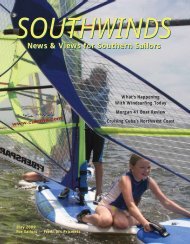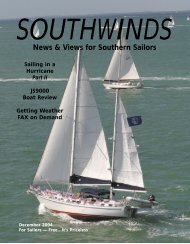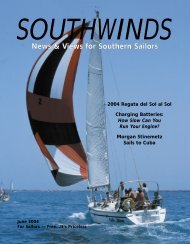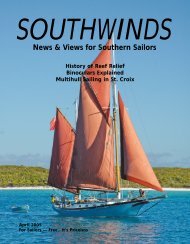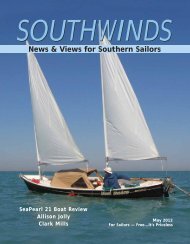Read PDF - Southwinds Magazine
Read PDF - Southwinds Magazine
Read PDF - Southwinds Magazine
Create successful ePaper yourself
Turn your PDF publications into a flip-book with our unique Google optimized e-Paper software.
LOA: 16’2”<br />
Beam: 7’4”<br />
Draft, board<br />
down: 37”<br />
Hull Weight:<br />
Sail area (sq ft):<br />
Mainsail: 124<br />
Jib: 40<br />
Spinnaker: 126<br />
Crew max<br />
weight:<br />
200 pounds<br />
400 pounds<br />
John Drawe designed the Raider when he got<br />
tired of being uncomfortable in order to go fast on<br />
a small boat.<br />
When author Dave Ellis, sailing here, first saw<br />
the raider, he thought it “looked as if it was flying<br />
through the clouds while sitting there on<br />
the trailer.”<br />
board quickly rights the boat. I get back aboard over the<br />
low, wide transom area.<br />
The US SAILING Portsmouth Handicap for the Raider<br />
Sport, as the boat with asymmetrical spinnaker is called, is<br />
91.4, about the same as a Snipe. With the jib correction, it is<br />
89.1, a little faster than the Windmill. Racing at Davis Island<br />
Yacht Club, near Tampa, FL, on Thursday evenings, proved<br />
that this handicap was pretty close to accurate. The Raider<br />
with jib and asymmetrical managed to win the spring series<br />
in the dinghy class. Much experimenting was done thereafter<br />
with the rake, jib lead position, spinnaker launch and<br />
retrieval systems, etc. The results showed inconsistency as<br />
some things worked and some not so much. That’s research<br />
THE Raider Turbo<br />
Fast exciting sailing —without the<br />
frequent swimming associated with<br />
high-performance dinghies<br />
Starting at $7,580<br />
Sail a Raider<br />
RAIDER DEMO DAY<br />
Sail the Raider & meet<br />
the designer, John Drawe<br />
SUNDAY, NOV. 7<br />
2:00-4:00 P.M.<br />
Gulfport Yacht Club<br />
Gulfport, FL<br />
Call or go to our Web<br />
site for more information<br />
The Raider<br />
Turbo with<br />
spinnaker<br />
Visit our Web site for a great<br />
demo video, photos and more:<br />
www.raidersailboats.com<br />
JOHANNSEN BOAT WORKS, INC.<br />
690 4th Place • Vero Beach, FL 32962<br />
800-869-0773 • info@raidersailboats.com<br />
and development for you.<br />
After many test sails in various conditions it was time<br />
to make recommendations for changes to make this boat<br />
approach its great potential.<br />
Johannsen took the hull plug to master shaper, Paul<br />
Keller, of Georgia, who gave the hull that little bit of rocker<br />
that water likes. The dagger board trunk was moved forward<br />
a couple of inches to balance the jib. The big change,<br />
however, was to the bow area. The original Raider hull had<br />
the forward section really narrow, almost catamaran-like,<br />
for the first three feet, then gently sweeping back and up to<br />
the hull form and the wings. It looked great.<br />
In smooth conditions, the boat slipped through the<br />
water so quietly that the speed was not noticed until another<br />
boat was near to compare. But wave action of any note<br />
was a problem. That bow pierced the wave like a multihull.<br />
But the wings then served as a barrier, and the stopping<br />
action was marked.<br />
The new shape has the bow area angling straight back<br />
to the widest part of the boat progressively to each height of<br />
the topsides. Gone is the “destroyer bow” shape. As it turns<br />
out, there is less wetted surface and much more buoyancy<br />
for wave action.<br />
Sailing the new hull is a pleasure in waves. The boat<br />
turns quicker, too, as the bow and stern don’t tend to dig in<br />
like a modern catamaran when tacking.<br />
John Drawe designed the Raider when he got tired of<br />
being uncomfortable in order to go fast on a small boat. It<br />
was conceived as a high performance single-handed sailboat<br />
that does not take an expert to sail. With his background<br />
in automotive engineering, he knows how to design<br />
comfort. Exotic construction, the type that similar European<br />
boats have embraced, was avoided for cost-effectiveness<br />
and ruggedness. This allows the Raider to be—ready to<br />
sail—about half the price of the overseas counterparts.<br />
While the boat was originally designed for John to sail<br />
alone, it has so much room that a crew is quite comfortable.<br />
I found that in winds above 12 knots the boat is faster with<br />
a crew! It planes readily upwind with a crew but must be<br />
de-powered enough to not plane as easily when sailing<br />
alone. I tried a trapeze, but with the wings already getting<br />
the sailor way out there, I found it didn’t make enough difference<br />
to make up for the hassle.<br />
I’ve sailed many kinds of sailing craft, and I like the<br />
Raider so much that I bought the test boat.<br />
For more on the Raider, go to www.raidersailboats.com.<br />
News & Views for Southern Sailors SOUTHWINDS September 2010 45



